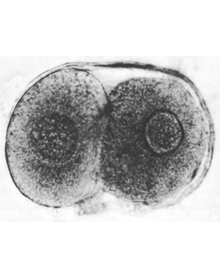The Stages of Human Embryonic Development
Stage 2 begins with the division of the zygote into two cells and ends with the appearance of the blastocystic cavity. Stage 2 embryos have an estimated postfertilization age of two to three days and are approximately 0.1 to 0.2 mm in diameter. The zygote undergoes cleavage during this period whereby it divides mitotically into an increasing number of cells that become progressively smaller with each division. The individual cells are called blastomeres and sometimes are referred to as founder cells because they give rise to embryonic stem cells. True growth does not occur during cleavage since the volume of the entire protoplasmic mass actually diminishes, however, the DNA content increases dramatically duplicating with each cell division.
Cleavage divisions do not occur synchronously so that stage 2 embryos are comprised of anywhere from one to sixteen blastomeres which can differ in their size, staining ability and electron density. During the early cleavage period the fate of each blastomere is not yet determined. The advanced embryo of 16 blastomeres or more is frequently called a morula as it resembles a mulberry.
| Browse the section images |
| 3D reconstructions |
| More info ... |
